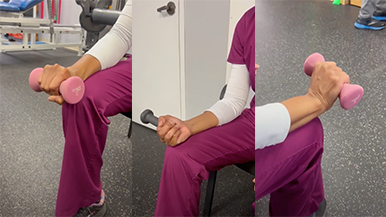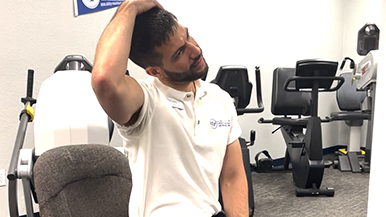 Sitting in a chair using a resistance band (2 exercises in one)
Sitting in a chair using a resistance band (2 exercises in one)- Squatting using a chair
- Chin in and out
- Push up using a table or desk
- Lunge at desk or table
- Sit and twist
There are a lot of benefits to working remotely (and cutting your commute time is just one of them). There are also some drawbacks. One of those is the potential for becoming more sedentary as you spend time moving from your couch to the home office. One recent poll showed the majority of telecommuters worry they aren’t getting enough exercise.
While we know exercise is important to both the mind and body, the data shows that it’s hard to motivate and organize your work day to include staying active. This blog will give you some concrete work-from-home exercises that you can do every day to stay fit and ensure healthy movement when working remotely.
1. Sitting in a Chair Using a Resistance Band
Working the pulling muscles
Austin Witnauer, board-certified orthopaedic physical therapist, PT, DPT, OCS at Ability Rehabilitation, says, “Under these unusual circumstances, the stressors of a pandemic going on, that can obviously put a burden,” on people working in their homes. He recommends two easy exercises that work well in a home office setting.
Start with a TheraBand or other resistance band. These affordable work-from-home exercise tools are elastic super-sized, rubber band-like devices that are perfect for both rehabilitation and fitness.
Stand up from your chair, placing the resistance band in each fist. Hold your arms in front of you and stretch your arms to either side, stretching the resistance band across your chest. Witnauer says, “It’s actually going to work all your pulling muscles.” That’s any muscles that you use regularly to reach down and pick up an item. One of the benefits of the exercise is that it gives you a break from the typical forward leaning posture that most people adopt when staring at their computer. Witnauer says, “This can give you a little variety so you can stay resilient.”
Working the pushing muscles
Place the resistance band behind your shoulders and bring both sides forward under your armpits. Hold the resistance band in both hands and extend your arms all the way forward. Then pull your arms backward like you’re rowing a boat. The benefits are the extension and reach of your arm and shoulder muscles to alleviate tension and build strength.
It’s a great idea to set an alarm to encourage you to get out of your chair two or more times a day to do these exercises. Now let’s look at another exercise that incorporates your home office chair into healthy movement.
2. Squatting Using a Chair
The chair you’re sitting in is a great tool for getting the job done. Unfortunately, too much sitting in that chair when you’re a remote worker can be bad for your health. Some researchers say, “Sitting is the new smoking.” Too much sitting seems to be connected to everything from diabetes to heart disease and even cancer.
Witnauer suggests turning that office chair into a partner in your work-from-home exercise routine. Here’s how it works:
- Stand up from your chair
- Holding your back straight, squat as if you’re going to sit—but don’t
- Instead, stand back up
- Repeat
This exercise works your thighs, calves, and even the gluteus maximus muscles. There’s another added benefit beyond your muscles. Witnaur says, “Research shows us that if we can engage with some decent activities in the midst of all this office work we’re doing from home, we become more productive with our work as well.”
3. Chin In and Out
This exercise can even be done when you’re sitting at your desk. First, sit up as tall as you can in your chair. Bring your chin directly straight backwards and tuck it against your neck. Then release it forward.
Witnaur says, “People like to joke around that they consider it a ‘double-chin exercise.’” The benefit is that it breaks that forward leaning posture and releases some of the tension in your neck and shoulders. Try doing five or 10 of these two or three times a day.
4. Push Up Using a Table or Desk
You can actually do a push up by using a table or a desk. Simply stand up and put your hands on the desk, counter, kitchen table—or other stable surface that you’re using to do your work at home.
Move your feet backward until your body is tilted toward your workstation. Keep your arms straight. Witnaur says, “Find that tolerable semi-plank position.” Then bend your arms and lower yourself down toward the desk as far as you can safely go. You don’t have to go all the way, but as far as you can effectively go and push yourself back up.
Witnaur suggests about five reps throughout the day if you’re just getting started and work your way up to 10 or 15. The benefits are the movement and stretching as well as strength building in your arms and shoulders.
5. Lunge at Desk or Table
Keeping your desk in front of you during this work-from-home exercise can allow it to provide you with a guide or even some balance support as you do the lunges. Start by standing in front of your desk.
Take a step backward with one leg so that your knee nearly touches the floor. Your goal is to have the front leg bearing most of the weight as it bends to support the body. During this exercise you can lean forward a little as your leg moves behind you. Rely on that front leg to do the work of lowering you down and pushing you back up.
This is a good leg exercise that will also help you improve your balance and agility. Start with about five on each leg once or more per day then increase your reps as you get more comfortable.
6. Sit and Twist
Witnaur says, “Normally if you’re sitting in one position for too long it’s good to take breaks.” That’s the whole idea of the sit and twist exercise, which uses your home office chair to incorporate a very beneficial exercise into your normal routine.
To do this exercise, stay seated in your chain and turn it from your desk so you’re facing an open space in the office. Sit back in your chair, raise your arms, and stretch them to either side of your body. Then lean forward with your left arm to touch your right toe. Keep the opposite arm extended during this process.
Sit back up, again stretching your arms to either side of your torso. Reverse the exercise, always touching the opposite toe from your arm. Stay as relaxed as possible and go down as far as you can. The benefit of the sit and twist is to work on your mobility in the trunk area.



